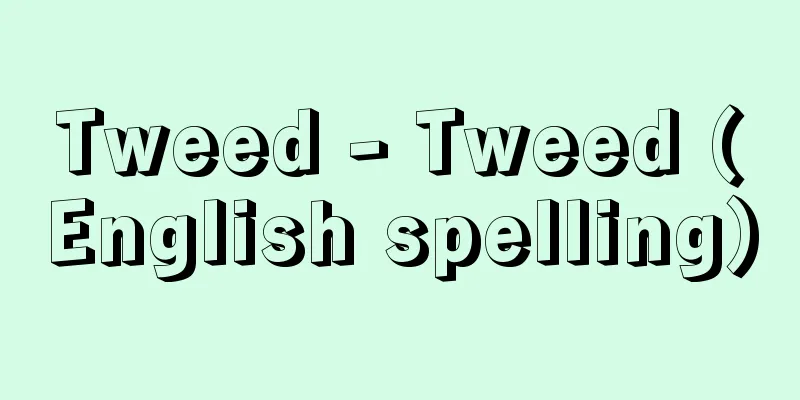Tweed - Tweed (English spelling)

|
Originally, it was a woolen fabric with a 2-2 twill weave made from Cheviot wool on the banks of the River Tweed, which flows along the border between Scotland and England. Until the mid-18th century, everything from shearing the wool to weaving was done by home industries, and it was called four-leaf twill in the region of production, but the Scots mis-spelled twill as tweel, and it is said that the London merchant who sold it named the fabric tweed, taking into account the name of the river and the misspelled twill. Today's tweeds are made using not only Cheviot wool but also similar wools to give them a tweed-like appearance, and include woolen fabrics woven on power looms with machine-spun woolen yarn. The fabric is made from thick hybrid wool, so it feels very rough to the touch, and because it is not felted or brushed, the weave is clear. The only difference is that homespun is a plain weave, whereas kiji is a twill weave, and the names are often used interchangeably. The most common patterns are marbled, solid, and herringbone striped. [Kadoyama Yukihiro] Scotch TweedScotch tweed is also known simply as tweed in Japan. It is the most basic fabric, but is sometimes used as a general term to include other types. One of the warp and weft strands is made of white woolen yarn, and the other is made of woolen yarn dyed black or other colors. [Kadoyama Yukihiro] Harris TweedHarris tweed is a hand-woven woolen tweed from the Outer Hebrides islands off the north coast of Scotland. It is the most expensive type of tweed. The name is a registered trademark of the Harris Tweed Association. It is a thick woolen fabric with a rustic feel. [Kadoyama Yukihiro] Irish TweedIrish tweed was woven as a side job by poor Irish farmers, using white warp threads and deep blue, dark brown, black and grey weft threads. [Kadoyama Yukihiro] Source: Shogakukan Encyclopedia Nipponica About Encyclopedia Nipponica Information | Legend |
|
もと、スコットランドとイングランドの国境を流れるツイード川河畔で、チェビオットcheviot羊毛からつくられた2―2斜文組織の毛織物。18世紀なかばまでは、羊毛の剪毛(せんもう)から製織まですべて家内工業で行われ、産地では四枚綾(あや)four leaf twillといっていたが、スコットランド人はツイルtwillをtweelと誤って綴(つづ)り、これを販売したロンドン商人は川の名と、誤綴(ごてつ)したツイルとから考えてtweedを織物名にしたといわれる。現在のものは、チェビオット羊毛ばかりでなく、これに似た羊毛を使い、外観をツイード風にくふうしたもので、機械紡績の紡毛糸により力織機で織った紡毛織物をも含めている。 生地(きじ)は、原料に太い雑種羊毛を用いるために手ざわりも非常に粗剛な感じであり、縮絨(しゅくじゅう)、起毛を行わないから織り目がはっきりしている。ホームスパンhomespunが平織であるのに対して綾織である点が異なるだけで、名称もしばしば混同して用いられている。柄は、霜降り、無地、杉綾の縞(しま)ものがもっとも多い。 [角山幸洋] スコッチ・ツイードScotch tweed日本では単にツイードともいい、もっとも基本的な生地であるが、ほかの種類のものを含めた総称として使うことがある。経緯(たてよこ)のうち一方を白の紡毛糸、他方を黒またはその他の色相にばら染めした紡毛糸を使う。 [角山幸洋] ハリス・ツイードHarris tweedスコットランド北岸のアウター・ヘブリディーズIslands of the Outer Hebrides諸島産の手織りの紡毛ツイードをさし、ツイードのうちでもっとも高価な種類である。名称は、ハリス・ツイード協会の登録商標になっている。厚手のウールで野趣に富む味のある生地である。 [角山幸洋] アイリッシュ・ツイードIrish tweedアイルランドの貧農の副業として織られたもので、経に白糸を、緯に濃藍(のうらん)色、暗褐色、黒、ねずみの色糸を用いている。 [角山幸洋] 出典 小学館 日本大百科全書(ニッポニカ)日本大百科全書(ニッポニカ)について 情報 | 凡例 |
Recommend
Toyoyama [town] - Toyoyama
A town in Nishikasugai County, western Aichi Prefe...
Papular syphilis rash - Syphilis papular rash
…At the same time, secondary syphilis rashes of v...
Ido Yasushi - Ido Yasushi
Physician. Born in Okayama Prefecture. After grad...
Elsass
…the region on the left bank of the Rhine in nort...
Einzelhof
... If we estimate the state of settlements and f...
liudzi z lasu (English spelling) liudzizlasu
…[Miyajima Naoki]. … *Some of the terminology exp...
Atosanupuri - Atosanupuri
A volcano located near Kawayu Onsen in Teshikaga ...
Kenmu Restoration
A dictatorial government ruled by Emperor Godaigo...
Myoshinji Temple
Located in Myoshinji-cho, Hanazono, Ukyo Ward, Ky...
Eckart, D.
...Its symbol was Ultima Thule, a legendary islan...
Yenangyaung (English spelling)
A town in central Myanmar, 46km north of Magway on...
Percentage - 100
Percentage is a percentage of the total amount. So...
γ-BHC - Gamma-BHC
… [kinds] The insecticides that have been used up...
Italian General Confederation of Labour - Confederazione Generale Italiana del Lavoro (English)
Abbreviated as CGIL (Chisil). Italy's largest...
Kiyomoto Saibei (3rd generation) - Kiyomoto Saibei [Sansei]
[raw]? [Died] Keio 3 (1867) He plays the shamisen ...









